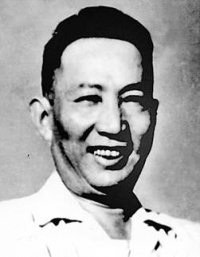
Fu Baoshi (Chinese: 傅抱石), or Fu Pao-Shih, (1904-1965) was a Chinese painter from Xinyu, Jiangxi Province. He went to Japan to study the History of Oriental Art in the Tokyo School of Fine Arts in 1933. He translated many books from Japanese and carried out his own research. In painting itself, he brought Japanese visual elements to the Chinese ink painting tradition.
He was the Director of the Jiangsu Province Chinese Painting School and a Vice-Chairman of the Federation of Chinese Artists. He also taught in the Art Department of Central University (now Nanjing University). His works of landscape painting employed skillful use of dots and inking methods, creating a new technique encompassing many varieties within traditional rules. He was able to create an old, elegant style through his integration of poetic atmosphere and painting techniques. He has held many personal exhibitions in China. In 2011 his first major retrospective exhibition in the west was held by the Cleveland Museum of Arts and the Nanjing Museum.
Fu had strong feelings towards the land of China. During his travel to many places, he recorded the splendors of the rivers and mountains, drawing inspiration from nature and becoming the representative landscape painter of his time.
(Click here to read more about Fu Baoshi on Google ).
Personally, Fu Baoshi was my favorite contemporary landscape painting master. I have learned his split-brush painting style through my teacher Huang Chunyao. I always love to read his painting books to learn. As you can see from my Youtube videos I have been teaching Baoshi style landscape painting in my Chinese brush painting class.
This e-book contains a collection of 50 Fu Baoshi's small paintings, including his early landscapes in the 1940s and East European landscapes of early 1960's.
Page 48
Dimension 14.17"(36cm) x 10.24"(26cm)
Color Plates
Published by Fu Baoshi Museum and Zhejiang Fine Arts Press, 1999
ISBN 7-5340-0903-O/J.778